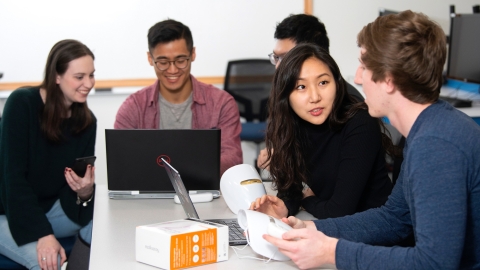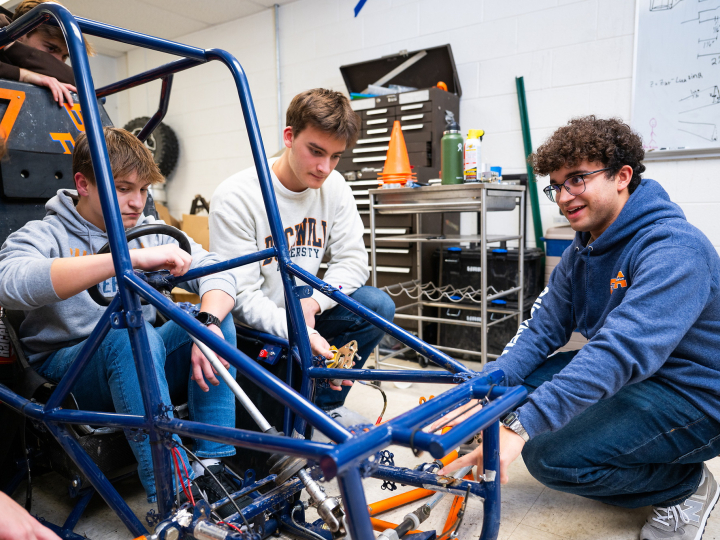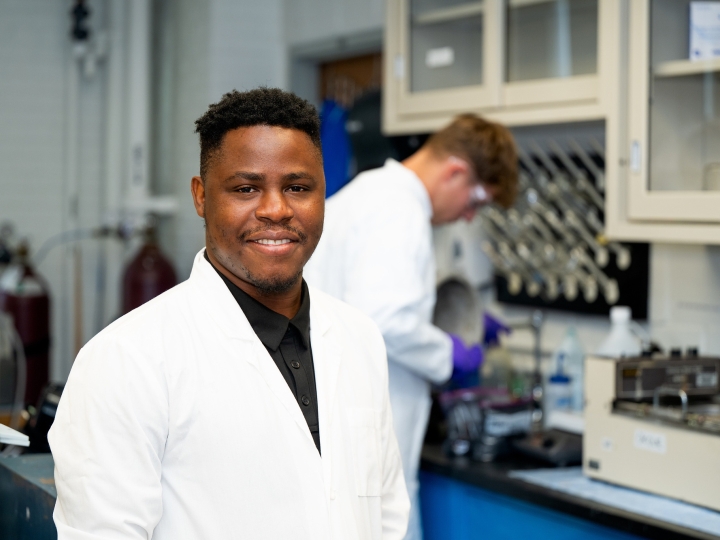
Inside Innovation: Senior Design Team Engineers App with Johnson & Johnson
June 7, 2019
Working together helped the team build closer relationships, as partners and friends. From left: Smith, Tse, Chen, Lee and Reilly. Photo by Emily Paine, Communications
The app Jae Young Lee '19 and her senior design team partners created didn't look like a student project. Seamlessly integrating with Neutrogena's line of light therapy masks for acne treatment, you might think it had been designed and tested by a team of professional coders, marketers and user-experience gurus.
Then again, that's exactly how their client treated them.
"We were held accountable for our technical and other knowledge, because no matter what, we were going to have a conference call with our client every Thursday and no matter what, we'd have to show progress," said Lee. "We felt a pretty strong responsibility for it."
Lee, a chemical engineering major from Seoul, South Korea, developed the app with a team of student-designers from an array of majors and hometowns around the world. They partnered with Johnson & Johnson, Neutrogena's parent company, who gave them their real-world product — which uses UV free LED lights to help clear acne-prone skin — and challenged them to create an innovative new way to interact with it.
Joining the effort were Gary Tse '19, a computer science & engineering major from New York City; Corrine Smith '19, a computer science & engineering major from Broomall, Pa.; Cade Chen '19, a computer engineering major from Beijing, China; and wild card Greg Reilly '19, an accounting & financial management major from Malvern, Pa., who had never taken an engineering course before.
They were among more than 30 project teams taking part in the College of Engineering's signature senior design experience, which challenges students to do more than to solve a problem, but become innovators in their fields. They joined those teams in proudly showcasing what they'd made at Bucknell's annual Senior Design Expo in April, but getting there was an effort nearly a year in the making.
Starting with a Blank Slate
The project began getting real from the start of the fall semester, when the team first met their project advisers and toured Johnson & Johnson's research center in Skillman, N.J. The company left them a broad goal but very few parameters, asking for a way for the light mask to communicate and interact with a user's cellular device — whether via Bluetooth, Wi-Fi or another technology — and an app to enable that interaction. But beyond those broad guidelines, the rest was up to the team.
"It's kind of daunting, because you're creating a platform where other people can actually interact with and see your work — it's out there," said Tse. "I started wondering whether people would find this useful, or what their motivations for using this application would be. We don't want to make something that not going to be used."
As the team dove into the different technical solutions that help them accomplish their goals, they quickly recognized the importance of that second question: Why would anyone want to use it?
They realized they needed to divide to conquer and split into two project teams. Chen, Smith and Tse would tackle the more technical aspects of enabling the light mask to communicate with a smartphone, while Lee and Reilly, leveraging his management experience, would research and define the ideal user experience. Project meetings twice a week would keep everyone on track.
"As different majors, we all bring different ideas to the table — if we were all computer science majors the outcome would probably be a lot different," Reilly said last fall. "I'm more heavily focused on the management side of the project, but I'm also interested the consumer behavior aspect and understand the target consumer."
Bonding Under Pressure
Those early efforts to understand their product and its use would benefit the team tremendously later on, but there was still a lot to do in the meantime — new programming languages to learn, consumer behavior to research and weekly conference calls with their client to hold them accountable.
"It's a constant repetition of working, showing it to the client, getting feedback and then rethinking, so that by the end, the client has been involved in the entire creation of the product that they asked for," Smith said.
Further complicating things was the fact that the only time they were all available to meet was after 9 p.m. But those challenges did offer an added, personal bonus. Through the late nights, long hours and setbacks, the students became more than teammates — they soon realized they were friends too.
"We're always having fun," Smith said. "When we have a meeting, we'll do it like somewhere we can get food — Gary cooked for our meeting the other day. And there's always sarcasm going on. I think that that like really helps that we can laugh when something goes wrong."
It also helped strengthen their connections to the greater Bucknell community, as they reached out to professors beyond their project advisers to pick their brains, including Professor Evan Peck, computer science — an expert in human-computer interaction.
"He gave some great advice on how to proceed and narrow our scope, because it's more effective to market toward one set of consumers and marketed to everyone," Chen said.
An Impressive Finish
By the end of the academic year, the team found that the planning and preparation they began a semester earlier had paid off. Beyond enabling the mask to communicate with their smartphone app, they developed a suite of value-added features to entice users to take advantage of the app — including a timer and a "skin mood" feature that offers daily, personalized skin care tips.
According to one of Johnson & Johnson's top executives, their client couldn't have asked for more. Michael Southall, global research & development lead for Johnson & Johnson's Skin Health business category, attended Bucknell's annual senior design expo to see what the team had created and was impressed by the results.
"We tried to give them a framework of what we thought success might look like, without defining exactly what it was — we wanted them to figure it out," Southall said. "And they did that both with engineering and computer programming, but also from a consumer engagement perspective. I think that's going to make this a successful product."
Southall also hinted that the project will have continued benefits for future Bucknell engineering students.
"We haven't actively recruited at Bucknell in the past, but going forward I think we'll be hiring more of these great engineering students to work for J&J," he said.

